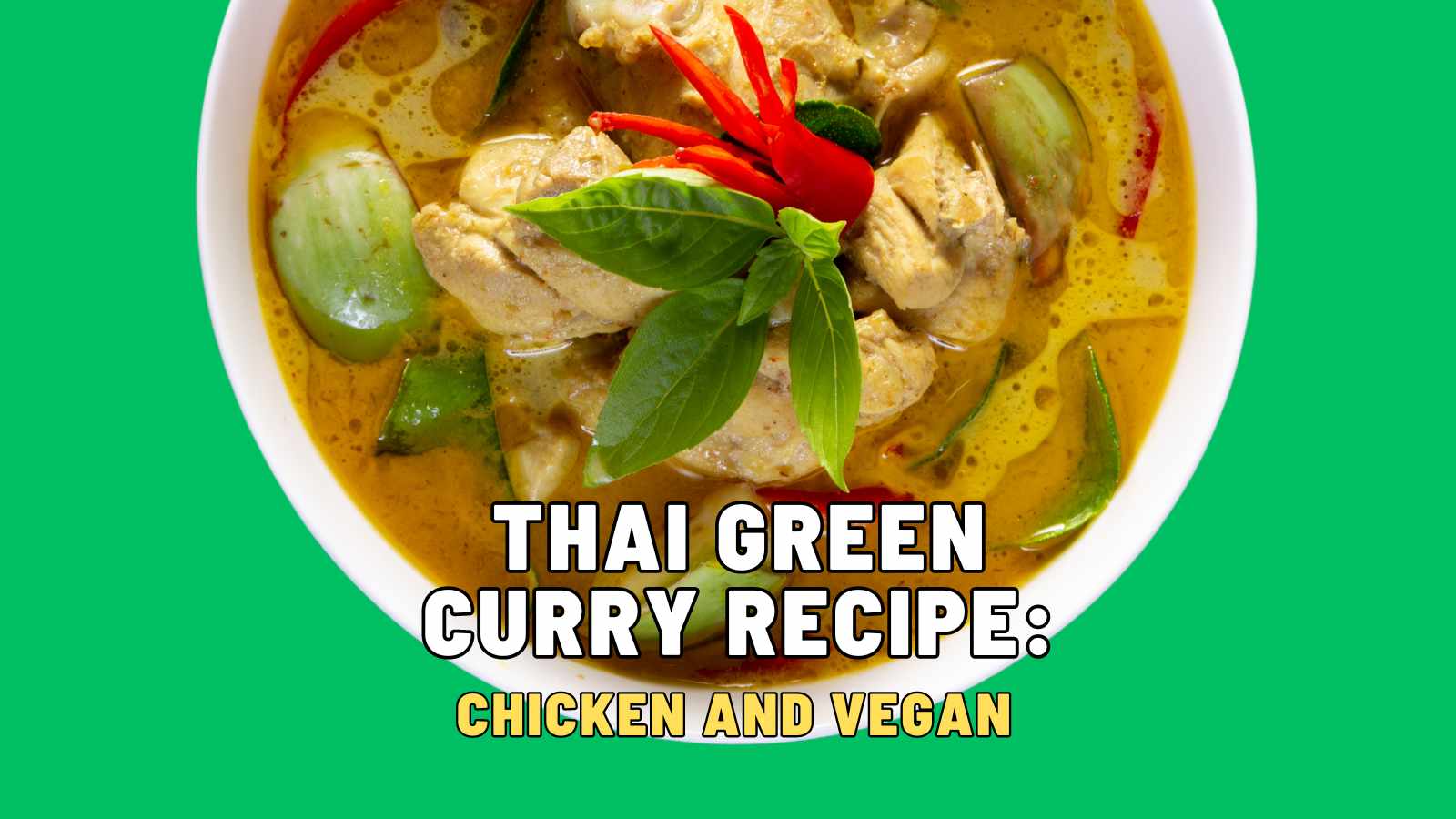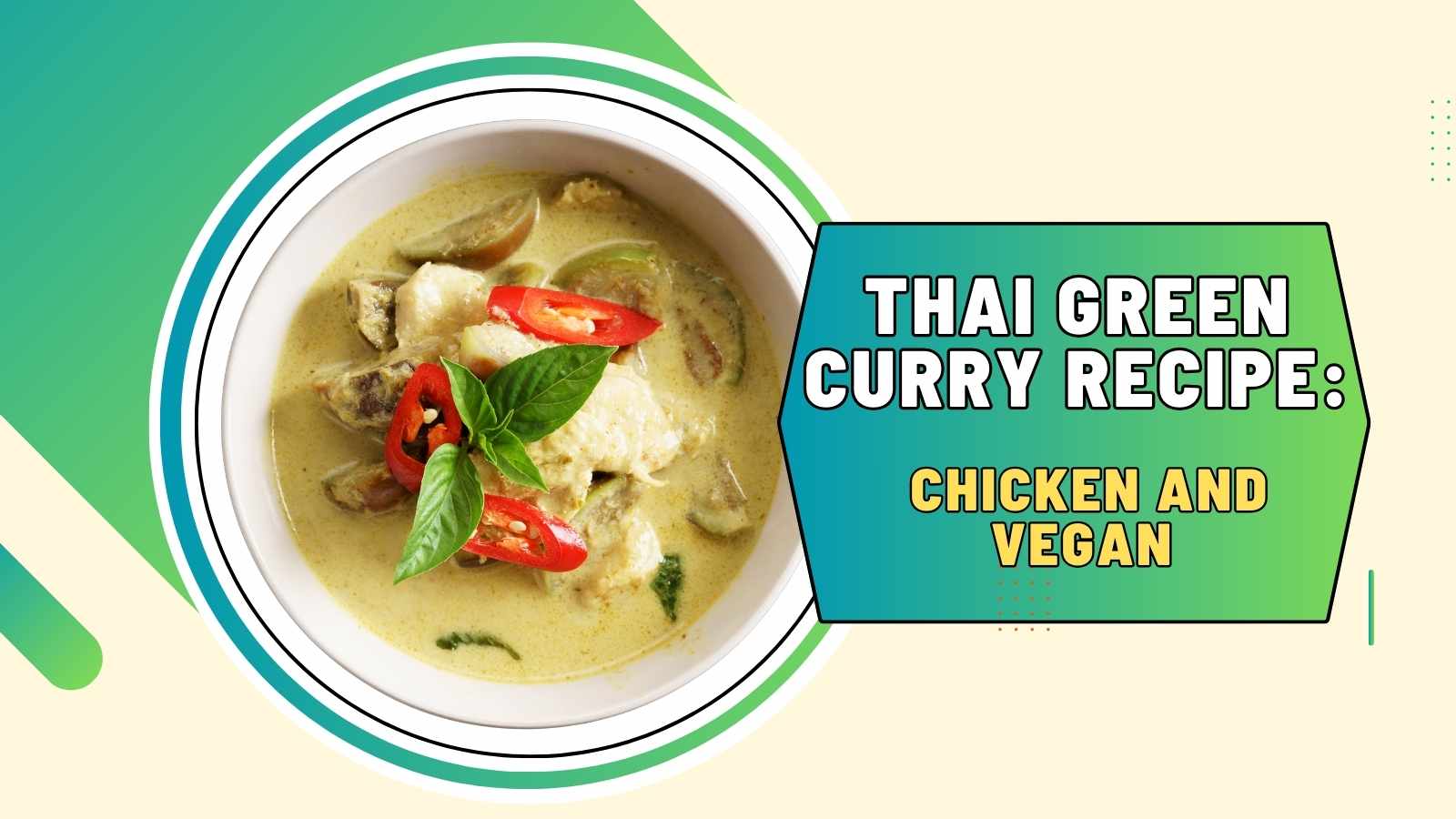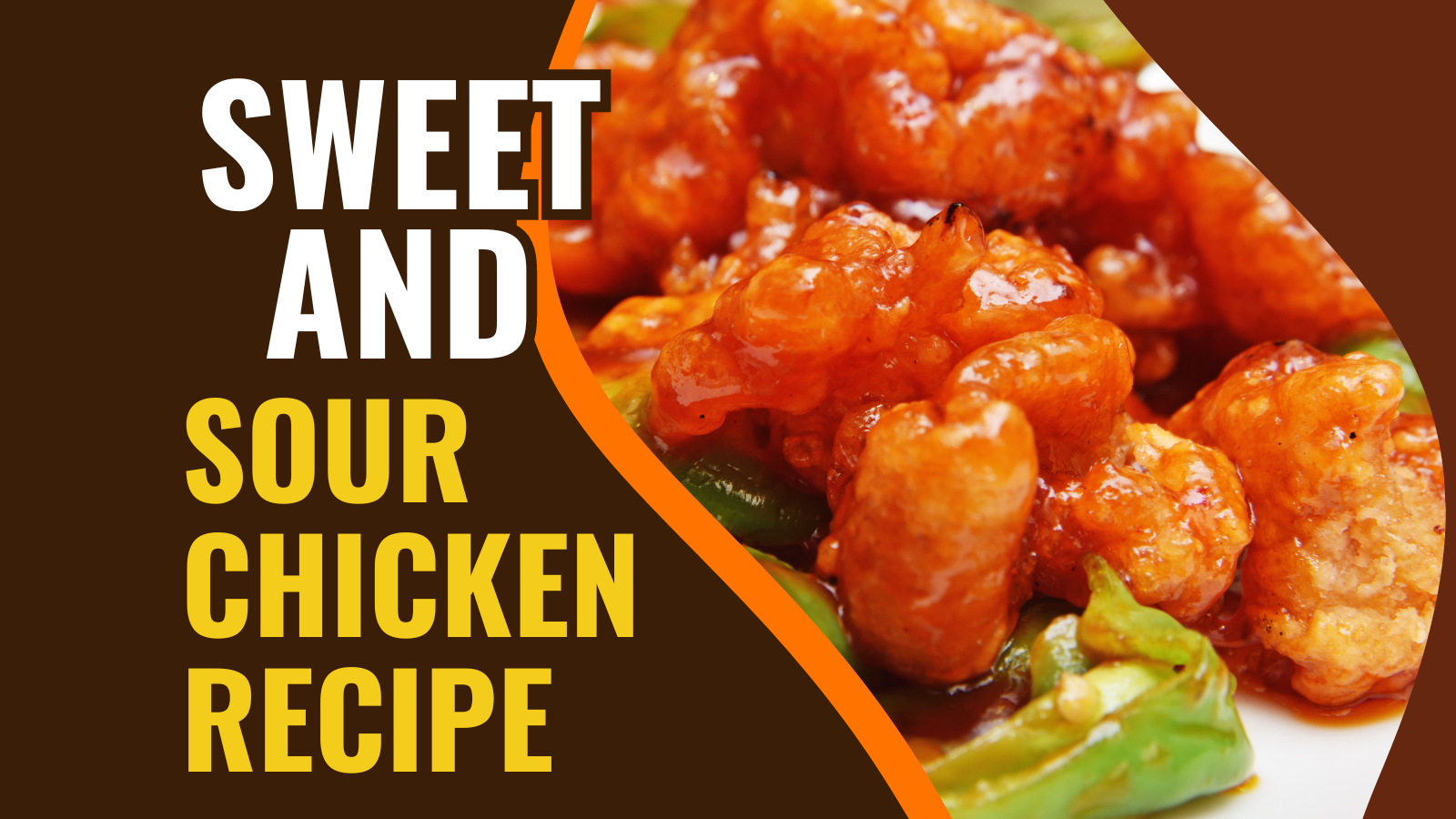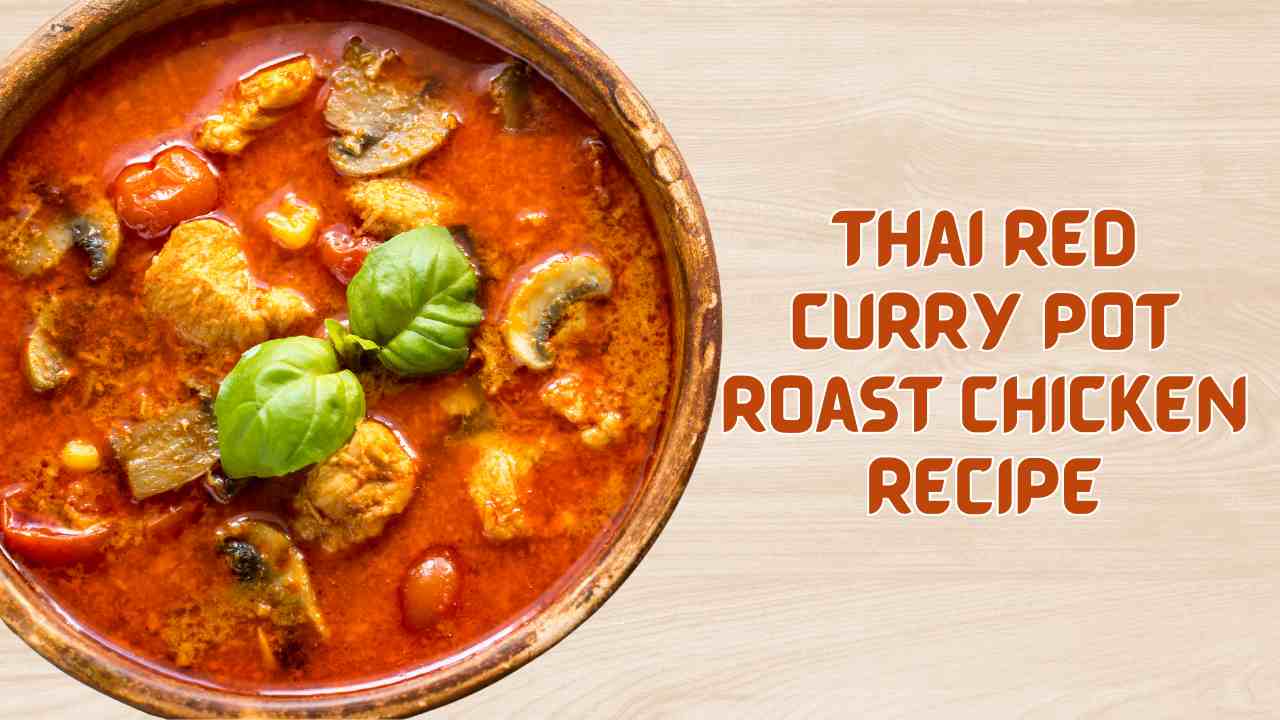Thai Green Curry is a delightful dish that embodies the vibrant flavors of Thai cuisine. Whether you’re a meat lover or a vegan, this aromatic curry offers a tantalizing blend of spices and ingredients that can cater to all tastes. Let’s know about Thai Green Curry and explore both chicken and vegan variations. It helps you to make this delicious dish at home.

Thai Green Curry Recipe: Chicken and Vegan
Ingredients for Thai Green Curry
Essential Ingredients for the Curry Paste
Creating an authentic Thai Green Curry starts with the curry paste. Here are the essential ingredients you’ll need:
- Green chilies
- Garlic cloves
- Shallots
- Lemongrass stalks
- Galangal or ginger
- Kaffir lime leaves
- Coriander roots or stems
- Cumin seeds
- Coriander seeds
- White peppercorns
- Shrimp paste (omit for vegan version)
- Salt
Once you have your curry paste ready, you can move on to the base of the curry.
Here are the key ingredients:
- Coconut milk
- Thai eggplants or regular eggplants
- Bamboo shoots
- Bell peppers
- Thai basil leaves
- Fish sauce (use soy sauce for vegan)
- Palm sugar or brown sugar
- Chicken breasts or thighs (for chicken version)
- Tofu or tempeh (for vegan version)
- Vegetables of your choice (for vegan version)
Preparing the Thai Green Curry Paste
- Traditional Method
For the most authentic flavor, make your curry paste from scratch. Here’s how:
Roast the Spices: Lightly roast the cumin seeds, coriander seeds, and white peppercorns in a dry pan until aromatic.
Pound the Ingredients: Using a mortar and pestle, pound the roasted spices with the remaining curry paste ingredients until you achieve a smooth paste. This can take some time but the flavors are worth it.
- Quick and Easy Method
If you’re short on time, you can use a food processor to blend all the curry paste ingredients. Add a little water or oil to help blend it smoothly. Store-bought curry paste is also a convenient alternative, though it may lack the depth of homemade paste.
Making Thai Green Curry with Chicken
Step-by-Step Instructions
- Prepare the Chicken: Cut the chicken into bite-sized pieces.
Cook the Curry Paste: Heat a tablespoon of oil in a large pot over medium heat. Add 2-3 tablespoons of the green curry paste and sauté until fragrant.
Add the Chicken: Add the chicken pieces and cook until they are no longer pink.
Pour in the Coconut Milk: Slowly add the coconut milk, stirring to combine.
Add Vegetables: Add the eggplants, bamboo shoots, and bell peppers. Simmer until the vegetables are tender.
Season the Curry: Add fish sauce and palm sugar to taste. Adjust the seasoning as needed.
Finish with Herbs: Stir in fresh Thai basil leaves just before serving.
Cooking Tips for Perfect Chicken Curry
- Balance the Heat: Adjust the number of chilies based on your spice tolerance.
- Don’t Rush: Let the curry simmer gently to allow the flavors to meld.
- Use Fresh Ingredients: Fresh herbs and vegetables will enhance the flavor and texture of your curry.
Making Vegan Thai Green Curry
Step-by-Step Instructions
- Prepare the Tofu/Tempeh: Cut the tofu or tempeh into cubes and lightly fry until golden.
- Cook the Curry Paste: Heat a tablespoon of oil in a large pot over medium heat. Add 2-3 tablespoons of the green curry paste and sauté until fragrant.
- Add the Coconut Milk: Slowly add the coconut milk, stirring to combine.
- Add Vegetables: Add your choice of vegetables such as bell peppers, broccoli, and carrots. Simmer until the vegetables are tender.
- Season the Curry: Add soy sauce and palm sugar to taste. Adjust the seasoning as needed.
- Finish with Herbs: Stir in fresh Thai basil leaves just before serving.
Substitutes for Vegan-Friendly Ingredients
- Soy Sauce for Fish Sauce: Soy sauce provides a similar salty umami flavor without the fish.
- Extra Vegetables: Add more variety with vegetables like zucchini, snap peas, and baby corn.
Cooking Techniques and Tips
Balancing Flavors
Thai cuisine is all about balancing sweet, salty, spicy, and sour flavors. Taste as you go and adjust the ingredients to suit your palate. If it’s too spicy, add more coconut milk or a bit of sugar. If it’s too sweet, a dash of lime juice can help balance it out.
Achieving the Perfect Consistency
The consistency of your curry can be adjusted by the amount of coconut milk and the cooking time. For a thicker curry, simmer longer to reduce the liquid. For a thinner curry, add more coconut milk or a bit of water.
Serving Suggestions
Ideal Side Dishes
- Jasmine Rice: The aromatic, slightly sticky rice complements the rich flavors of the curry.
- Rice Noodles: For a different texture, serve the curry over rice noodles.
- Fresh Salad: A simple cucumber salad can provide a refreshing contrast.
Presentation Tips
Serve your Thai Green Curry in a large bowl, garnished with fresh basil leaves and sliced red chilies for a pop of color. A wedge of lime on the side can also enhance the presentation and flavor.
Health Benefits of Thai Green Curry
Thai Green Curry is not only delicious but also packed with nutrients. The herbs and spices used in the curry paste have anti-inflammatory properties, while the coconut milk provides healthy fats. Vegetables add fiber and vitamins, making it a well-rounded meal.
Nutritional Differences: Chicken vs. Vegan
- Chicken Version: Higher in protein and typically higher in calories due to the meat.
- Vegan Version: Lower in calories and fat, depending on the type and amount of vegetables and tofu/tempeh used.
Tips for Beginners
- Overloading with Ingredients: Stick to the basics for your first few attempts. Too many ingredients can muddle the flavors.
- Skipping the Paste Frying Step: Always fry the curry paste before adding other ingredients to release the full aroma and flavor.
Common Pitfalls and How to Overcome Them
- Too Spicy: Add more coconut milk or a bit of sugar to balance the heat.
- Too Sweet: Add a dash of lime juice or a bit more fish/soy sauce.
Variations of Thai Green Curry
Regional Variations
Different regions in Thailand may use various ingredients and techniques. For example, some regions might use more seafood or local vegetables, giving the curry a unique twist.
- Green Curry Soup: Thinner consistency, served as a soup with noodles.
- Green Curry Fried Rice: Use the curry paste to flavor fried rice for a quick and tasty meal.
Storing and Reheating Thai Green Curry
Best Practices for Storage
Store any leftover curry in an airtight container in the refrigerator. It should last for up to 3 days.
Reheating Tips
Reheat gently on the stove over low heat, adding a bit of water or coconut milk if it has thickened too much. Avoid using the microwave as it can unevenly heat the curry.
Frequently Asked Questions
Can I Freeze Thai Green Curry?
Yes, you can freeze Thai Green Curry. Portion it into freezer-safe containers and it will keep for up to 3 months. Thaw in the refrigerator overnight before reheating.
What Can I Use Instead of Coconut Milk?
If you need a substitute for coconut milk, you can use almond milk or cashew cream for a similar creamy texture, though the flavor will be slightly different.
How to Make the Curry Less Spicy?
To make the curry less spicy, reduce the number of green chilies in the paste or add extra coconut milk to dilute the heat.
Can I Use Store-Bought Curry Paste?
Yes, store-bought curry paste is a convenient option and can save time. However, making your own paste can provide a fresher and more robust flavor.
What’s the Best Type of Rice to Serve with Thai Green Curry?
Jasmine rice is the best choice as its subtle aroma and slightly sticky texture complement the curry perfectly.
Can I Add Other Vegetables?
Absolutely! Feel free to add any vegetables you like. Zucchini, snap peas, and baby corn are great additions.
How Long Does It Take to Cook?
From start to finish, Thai Green Curry typically takes about 30-45 minutes to prepare and cook, depending on your method and ingredients.
Is Thai Green Curry Gluten-Free?
Yes, Thai Green Curry is naturally gluten-free. Just ensure that the soy sauce or other substitutes you use are also gluten-free.
Conclusion
Thai Green Curry is a versatile and flavorful dish that can be tailored to both meat lovers and vegans alike. By following this guide, you can create an authentic and delicious Thai Green Curry at home, impressing your friends and family with your culinary skills. Remember, the key to a great curry is balancing the flavors and using fresh ingredients. Happy cooking!



